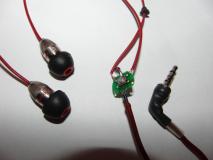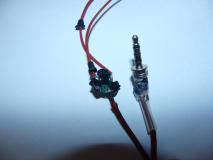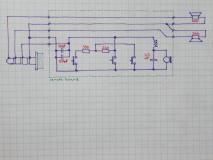
headset A schematics

Headset A, control board

Headset A, control board

Headset A, control board and connector

Headset A, control board and connector

Headset A, housing inside

Headset A, housing outside
Many smartphone headsets these days feature remote control buttons. Their connection is usually poorly documented. A pair of earphone headsets with broken connectors was reverse-engineered during the course of their repair. Both headsets use the standard "TRRS" 3.5mm audio jack and are compatible with Android smartphones.
The remote control is realized as a switch or several switches connected in parallel to the headset microphone. One switch is just shorting the microphone, the optional ones have a several hundreds ohm resistor in series.
The microphone is powered from the phone side via a resistor. Normally, the microphone acts as an active load on the line, pulling the voltage on the resistor down a little; the AC waveform that carries the sound is isolated via a capacitor and the DC potential on the microphone line is ignored. The remote control adds a parallel low-impedance path to the microphone. Shorting it acts as a button for play/pause or call reception, shorting it through a 220-ohm or 600-ohm resistor acts as a rewind/fastforward button.
The headset "A" is the "Atomic Floyd" brand, fairly high-end, equipped with call receiving button located in a remote-control housing. The damage was a wear of the cable at the points it comes out of the jack and out of the remote control housing, manifesting as unreliable performance strongly dependent on the angles and twists of the cable.
The remote housing, which also houses the microphone, is a metal shell composed from two interference-fitted parts. A thin short slit was cut into the housing along the seam, and a screwdriver used to pry the halves apart. The housing contained a small circuitboard, with a tiny microphone and a pushbutton. The circuitboard had an unpopulated position for a capacitor in parallel to the microphone. The pushbutton was connected in parallel to the microphone.
 headset A schematics |  Headset A, control board |  Headset A, control board |  Headset A, control board and connector |
 Headset A, control board and connector |  Headset A, housing inside |  Headset A, housing outside |
The headset "B" is the "Monster iBeats" brand, equipped with three buttons for fastforward, rewind, and play/stop/call receive. The damage was a cable wear on the connector.
The remote housing, also housing the microphone, is a plastic shell with three separate snap-on buttons on one side. Gentle prying released the buttons. There is a thin narrow circuitboard in the housing, to which the microphone, the tactile switches for the remote, and some passive parts are soldered; the boad can be released by gentle prying it off the snap-in holders.
The circuitboard contains more passive parts than the "A" model. The main difference is the presence of the capacitors and a choke in the microphone circuit; these probably serve for suppressing the EMI interference induced into the cable from the phone's transmitter. The remote control buttons are connected in parallel to the microphone like with the model "A"; the fastforward and rewind ones have fixed resistors in series. The resistors are connected in a way that gives clear priority to the buttons when multiple are connected together; the one with the lower-value resistor (including direct connection by the middle button) takes precedence.
 headset B schematics |  Headset B, control board |  Headset B, control board |  Headset B, control board |